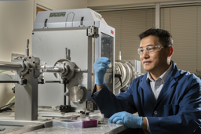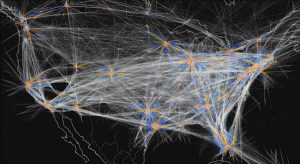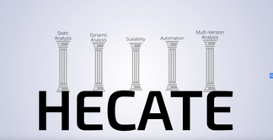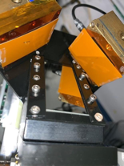Binary Solvent Diffusion for Fabrication of Large Nanoparticle Supercrystals

Using an artful combination of nanotechnology and basic chemistry, Sandia synthesized and self-assembled gold nanoparticles into unusually large millimeter size supercrystals that could significantly improve the detection sensitivity for trace amounts of chemicals. The enhanced sensing capability derives from giant electromagnetic field enhancements between the self-assembled gold nanoparticles enabled by localized surface plasmon resonance of nanoparticles within the supercrystals. The enhanced performance of these materials is specifically correlated to their shape, size, and packing density. Sandia’s Extended LaMer synthesis of nanoparticles allows precise tunability of the shape, size, composition, and other functional properties for optimization of the plasmonic coupling for superior sensitivity. Control over the structure of these supercrystals is achieved through a seeding and growth process by using a binary solvent diffusion method. Together, these methods enable large-scale production of the materials for reduced cost. Besides sensing, the supercrystals obtained through this process possess superior performance in important applications including optoelectronics, photovoltaic, and surface catalysis.
Tracktable

Tracktable is a set of trajectory analytics used to apply advanced machine learning techniques to large trajectory data sets. It enables searches for shapes and patterns in space and time by providing a mathematical framework to describe such patterns. Given that framework, Tracktable provides tools for fast search and categorizations in order to organize, search, and quickly analyze millions of patterns enabling the computer to group similar shapes together and to find unique or unusual trajectories without first requiring humans to define “normal”. Additionally, its ability to treat time as a variable, similar to space, enables searches for collective behavior and patterns over long periods of time. Finally, fast search techniques enable Tracktable to predict the paths and destinations of moving objects by comparing their observed paths to historical databases of trajectories. The notion of fundamentally representing the trajectory as a vector of “features” is the key idea that makes this approach different from previous trajectory analysis techniques.
High-density Evaluator of COTS Applications for Trust and Efficacy (HECATE)

Sandia’s HECTATE platform is a multifaceted approach to providing varied and measured elements to accumulate trust in both compiled commercial products and opensource software. HECTATE is comprised of virtual and physical assets that integrate to create a wholly immersive environment to install, execute, excite and observe software. The target software is installed on virtualized machinery whose attributes have been modified to resemble physical devices. The platform is constructed such that inputs to the target software may “fuzzed” out-of-band through mechanisms that are not exigent on the virtual machine (VM); outputs from the excitation of inputs are then observed in a similar out-of-band fashion. These approaches are implemented without the use of agents making them observable from the guest VM, which allows the software to proceed unimpeded by observation. The system also allows the ability to fold time, facilitate external network connectivity and communication, and dynamically respond to benign, anomalous and suspected/confirms malicious behaviors.
Institute for the Design of Advance Energy Systems (IDAES) Process Systems Engineering (PSE) Computational Framework

This next-generation multi-scale framework is a comprehensive, integrated set of PSE tools that support the design, modeling, and optimization of advanced energy systems from rigorous analysis to system-wide optimization. The tools have broad potential application, including the support of existing fossil generation systems, the design of new hybrid generation systems, or the evaluation of new technologies in the context of the broader power system.
Co-developing organizations: National Energy Technology Laboratory, Carnegie Mellon University, West Virginia University, and the University of Notre Dame.
XRPBS: X-ray Polarizing Beam Splitter

XRPBS is the first x-ray polarizing beam splitter in existence. It has the ability to separate an x-ray beam in two in order to measure each polarized beam simultaneously, which makes it an outstanding diagnostic for many types of experiments and a valuable high-synchrotron resource for scientific research facilities.
Co-developing organizations: Nevada National Security Site, Argonne National Laboratory, and EcoPulse.
Legion: A Data-Centric Programming System
Legion is a data-centric HPC programming system and open-source software tool that boosts application performance and speed of computing by automating task scheduling and data movement.
Co-developing organizations: Los Alamos National Laboratory, NVIDIA University of California – Davis, Sandia National Laboratories, Stanford University, SLAC National Accelerator Laboratory